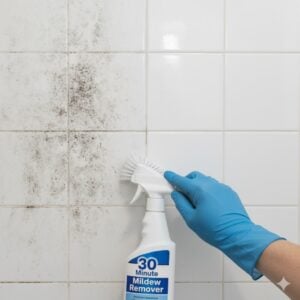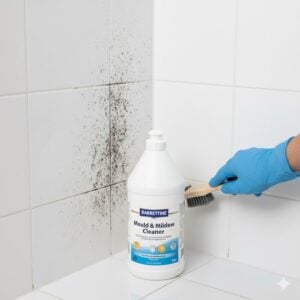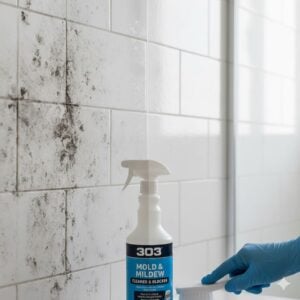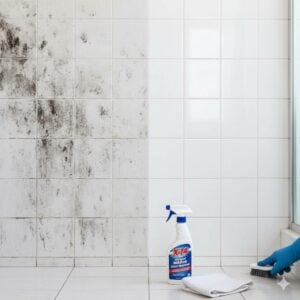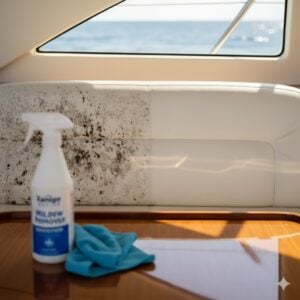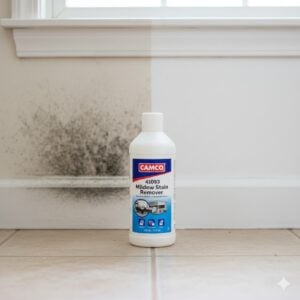Mildew might start as a few small spots, but if ignored, it can quickly spread and stain your walls, furniture, or bathroom tiles—bringing health risks and that musty smell nobody wants. If you’re living in the UAE, where humidity often creeps into homes through AC units and closed spaces, knowing how to clean mildew properly is a must. In this article, we break down exactly how you can clean mildew from different surfaces, prevent it from returning, and understand when it’s time to call professionals.
Table of Contents
Toggle1. What Is Mildew and Why It Happens in UAE Homes
Mildew is a type of fungus—related to mold—that typically appears as flat, powdery patches in shades of white, gray, or light brown. It grows in damp, poorly ventilated environments, and while it’s not as deep-rooted or dangerous as black mold, it can still cause respiratory irritation, especially for kids and the elderly.
In the UAE, mildew thrives in:
- Air-conditioned rooms with poor ventilation
- Bathrooms with no exhaust fan or open window
- Closets and wardrobes against cold walls
- Under carpets or rugs placed over concrete floors
Humidity from the sea, mixed with sealed windows and strong AC use, creates a perfect recipe for mildew growth. That’s why it’s so common even in new apartments across Dubai, Abu Dhabi, and Sharjah.
2. Step-by-Step: How to Clean Mildew on Walls and Ceilings
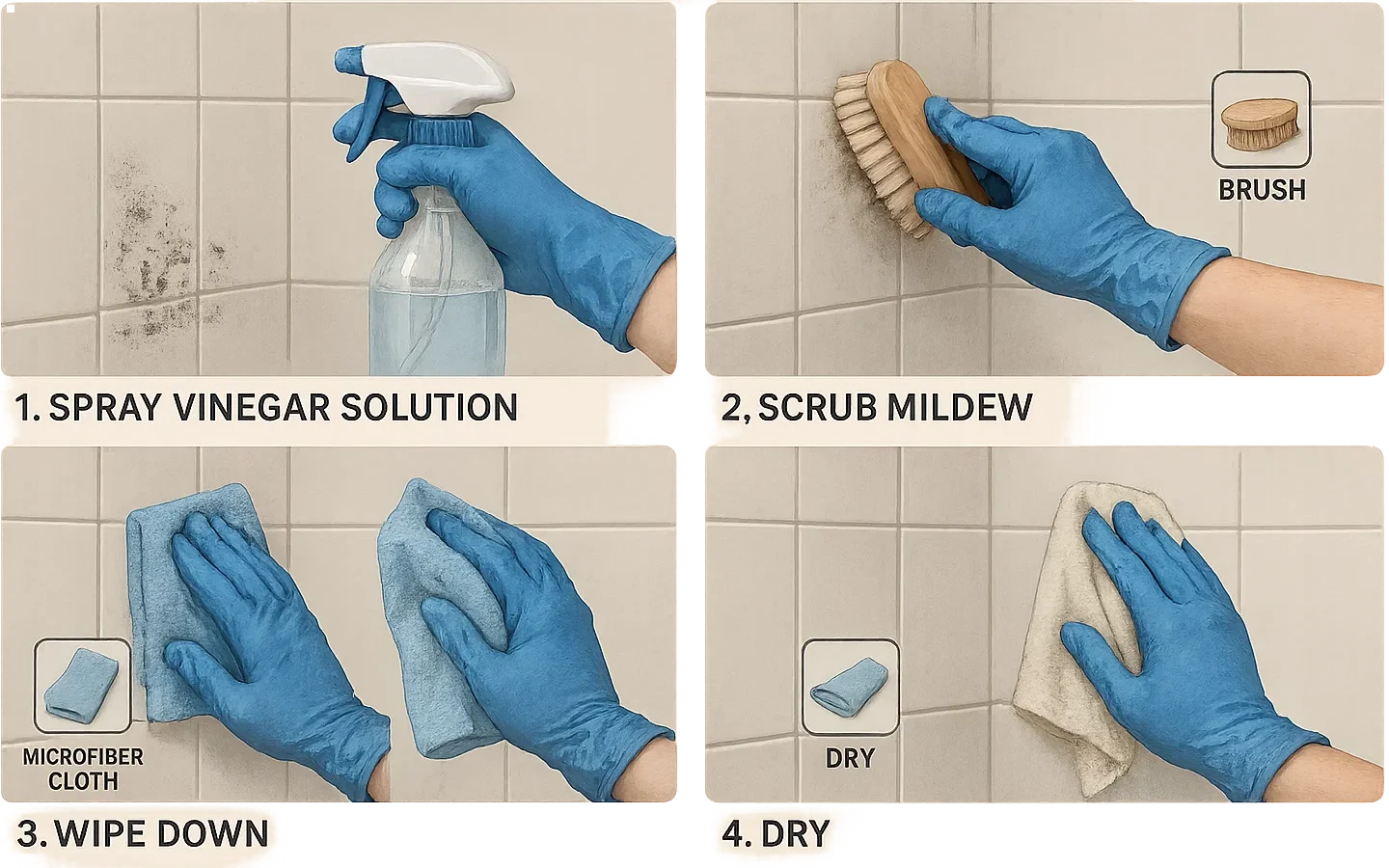
Before anything else, protect yourself. Put on gloves, wear a mask (especially if you’re cleaning a ceiling), and open windows or turn on an exhaust fan. You don’t want to inhale spores while cleaning.
Here’s the simple DIY method for small areas:
- Mix your solution: Combine 1 cup of white vinegar with 1 cup of warm water in a spray bottle. For tougher mildew, use vinegar undiluted or mix with baking soda.
- Spray and soak: Spray the affected area and let it sit for 10–15 minutes. Don’t rush this—it needs time to break down the mildew roots.
- Scrub gently: Use a soft-bristle brush or sponge to scrub. Avoid hard scrubbing on painted walls to prevent damage.
- Rinse and wipe: Wipe with a damp cloth and then dry the area with a microfiber towel. Drying is essential—mildew loves leftover moisture.
Never mix vinegar with bleach—it creates toxic fumes. If you’re unsure, just stick with white vinegar or use a commercial mildew remover that says “safe for indoor use.”
3. Cleaning Mildew from Fabric, Upholstery, and Carpets
Mildew doesn’t only grow on walls—it’s just as happy in your curtains, cushions, and carpets. Fabric is more delicate, so be careful with what cleaning agents you use.
Here’s how to deal with mildew on soft surfaces:
- Take it outside: First, bring the affected item outdoors to prevent spores from spreading inside your home.
- Brush off loose mildew: Use a soft brush or vacuum with a HEPA filter. If brushing, wear a mask to avoid inhaling spores.
- Apply diluted vinegar: Spray a mix of vinegar and water directly onto the mildew. Let it sit for 15–20 minutes.
- Blot, don’t soak: Use a clean cloth to blot the area. If the mildew persists, consider steam cleaning or professional fabric sanitizing services.
Carpets are tricky—once mildew settles deep, DIY methods might not work. Bio-On offers deep extraction and anti-fungal carpet treatments in the UAE if you need help restoring rugs or wall-to-wall carpeted rooms.
4. How to Stop Mildew from Coming Back
Cleaning mildew is one thing—stopping it from coming back is another. In many UAE homes, mildew returns not because the cleaning wasn’t good enough, but because the root cause was ignored.
To truly prevent mildew, you need to tackle moisture:
- Use a dehumidifier: Especially in bedrooms or walk-in closets where AC runs cold but airflow is low.
- Keep air moving: Open windows during cooler hours or run an exhaust fan regularly. Ceiling fans also help.
- Fix water leaks fast: Even tiny drips behind a sink or wall can cause mildew to grow in hidden spots.
- Choose mold-resistant paint: Especially for bathrooms and kitchens—look for options labeled “anti-mold” or “fungicidal.”
If your home keeps getting mildew in the same areas over and over, it might be time for a moisture inspection. We offer free checks in most areas of Dubai and Sharjah—just click the contact button on the right-middle of this post and book a slot.
5. When to Call a Mildew Cleaning Professional
You don’t always need a pro, but here are signs it’s time to call one:
- The mildew covers a large area (more than 1 square meter)
- It keeps returning even after cleaning
- You smell mildew but can’t find the source
- It’s affecting fabric furniture, air ducts, or inside walls
We get calls all the time from families frustrated by recurring mildew patches that cleaners or DIY sprays can’t fix. That’s because the real cause is deeper—moisture in the walls, trapped humidity, or even AC drain issues.
Our team at Bio-On is trained in both visible and hidden mildew remediation, and we always clean without harsh chemicals—so you can breathe easy again.
Conclusion
Whether you’re dealing with mildew in your bathroom, bedroom, or soft furniture, the key is to act fast, clean carefully, and solve the moisture issue causing it. Vinegar, ventilation, and good habits go a long way—but for deeper or recurring cases, professional help might be your best move.
Need advice or a quick inspection? Click the contact button on the right-middle of this post and let’s talk—no pressure, just helpful support from a UAE-based team that knows what mildew really means in this climate.







